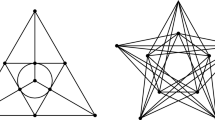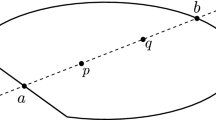Abstract
A hereditary class ℋ of combinatorial geometries (or simple matroids) is a collection of geometries closed under minors and direct sums. A geometry G in ℋ is extremal if no proper extension of G of the same rank is in ℋ. The size function h(n) of ℋ is defined by h(n)=max {|G|: G∈ℋ and rank(G)=n}, where |G| is the number of points in G. A hereditary class is numerically regular if for every extremal geometry G in ℋ, |G|=h (rank(G)). We determine all the numerically regular hereditary classes for which the set {h(n)−h(n−1): 1≤n<∞} of positive integers does not have an upper bound: they are all varieties. We also give several examples of numerically regular hereditary classes which are not varieties.
Similar content being viewed by others
References
Birkhoff, G., Lattice Theory (3rd edn), Amer. Math. Soc. Colloq. Publ., Vol. 25, Amer. Math. Soc., Providence, R. I., 1967.
Brylawski, T., ‘Modular Constructions for Combinatorial Geometries’, Trans. Amer. Math. Soc. 203 (1975), 1–44.
Crapo, H. H. and Rota, G.-C., On the Foundations of Combinatorial Theory: Combinatorial Geometries (Prelim. edn), M.I.T. Press, Cambridge, Mass. 1970.
Edmonds, J., ‘Submodular Functions, Matroids, and Certain Polyhedra’, Combinatorial Structures and their Applications (Proc. Calgary Internat. Conf., Calgary, Alberta), Gordon and Breach, New York, 1970, pp. 69–87.
Inukai, T. and Weinberg, L., ‘Whitney Connectivity of Matroids’, SIAM J. Alg. Discrete Methods 2 (1981), 108–120.
Kahn, J. and Kung, J. P. S., ‘Varieties of Combinatorial Geometries’, Trans. Amer. Math. Soc. 271 (1982), 485–499.
Kahn, J. and Kung, J. P. S., ‘A Classification of Modularly Complemented Geometric Lattices’, Europ. J. Comb. (to appear).
Li, W., ‘On Matroids of the Greatest W-Connectivity’, J. Comb. Theory 35 (1983), 20–27.
Mader, W., ‘Homomorphieeigenschaften und mitlere Kantendichte von Graphen’, Math. Ann. 174 (1967), 265–268.
Ore, O., The Four-Color Problem, Academic Press, New York, London, 1967.
Stanley, R. P., ‘Modular Elements of Geometric Lattices’, Algebra Universalis 1 (1971), 214–217.
Stonesifer, J. R., ‘Modularly Complemented Geometric Lattices’, Discrete Math. 32 (1980), 85–88.
Wagner, K., ‘Bemerkungen zu Hadwigers Vermutung’, Math. Ann. 141 (1960), 433–451.
Welsh, D. J. A., Matroid Theory, Academic Press, 1976.
White, N. L. (ed.). Theory of Matroids, Cambridge Univ. Press, Cambridge, 1985.
Whitney, H., ‘Non-separable and Planar Graphs’, Trans. Amer. Math. Soc. 34 (1932), 339–362.
Zaslavsky, T., ‘Signed Graphs’, Discrete Appl. Math. 4 (1982), 47–74; erratum, ibid. 5 (1983) 248.
Author information
Authors and Affiliations
Additional information
Partially supported by a North Texas State University Faculty Research Grant.
Rights and permissions
About this article
Cite this article
Kung, J.P.S. Numerically regular hereditary classes of combinatorial geometries. Geom Dedicata 21, 85–105 (1986). https://doi.org/10.1007/BF00147534
Received:
Issue Date:
DOI: https://doi.org/10.1007/BF00147534




